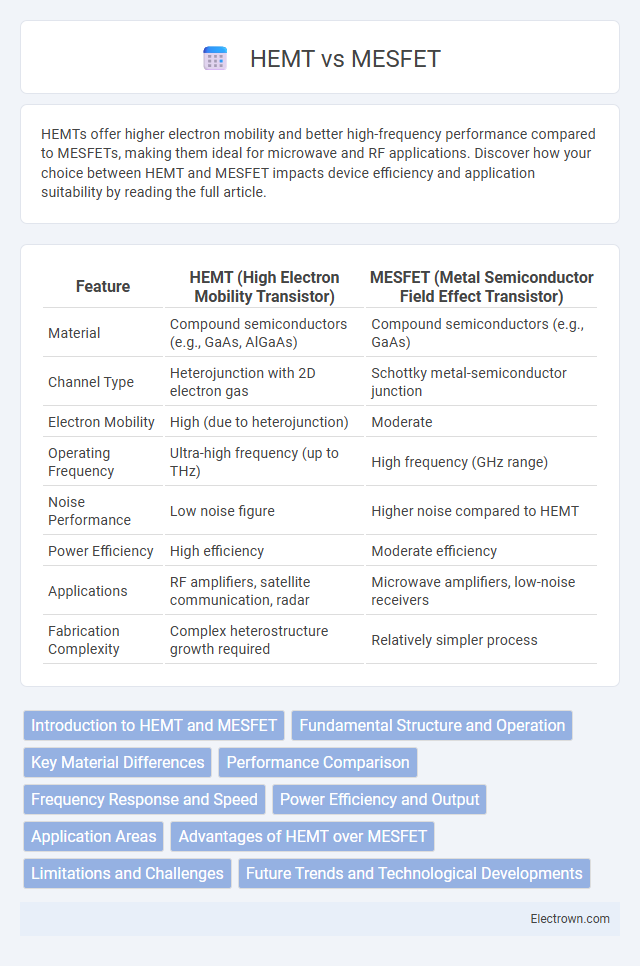HEMTs offer higher electron mobility and better high-frequency performance compared to MESFETs, making them ideal for microwave and RF applications. Discover how your choice between HEMT and MESFET impacts device efficiency and application suitability by reading the full article.
Table of Comparison
| Feature | HEMT (High Electron Mobility Transistor) | MESFET (Metal Semiconductor Field Effect Transistor) |
|---|---|---|
| Material | Compound semiconductors (e.g., GaAs, AlGaAs) | Compound semiconductors (e.g., GaAs) |
| Channel Type | Heterojunction with 2D electron gas | Schottky metal-semiconductor junction |
| Electron Mobility | High (due to heterojunction) | Moderate |
| Operating Frequency | Ultra-high frequency (up to THz) | High frequency (GHz range) |
| Noise Performance | Low noise figure | Higher noise compared to HEMT |
| Power Efficiency | High efficiency | Moderate efficiency |
| Applications | RF amplifiers, satellite communication, radar | Microwave amplifiers, low-noise receivers |
| Fabrication Complexity | Complex heterostructure growth required | Relatively simpler process |
Introduction to HEMT and MESFET
HEMT (High Electron Mobility Transistor) uses a heterojunction interface to achieve higher electron mobility and faster switching speeds compared to MESFET (Metal-Semiconductor Field-Effect Transistor), which relies on a Schottky contact on a single semiconductor material. HEMTs are widely used in high-frequency and high-power applications thanks to their superior performance in IV-characteristics and noise figures. Understanding the differences between HEMT and MESFET technology helps optimize your choice for RF amplifiers, satellite communications, and microwave circuits.
Fundamental Structure and Operation
HEMTs (High Electron Mobility Transistors) utilize a heterojunction structure formed by layering different semiconductor materials, such as GaAs and AlGaAs, creating a two-dimensional electron gas (2DEG) channel with high electron mobility for faster operation. MESFETs (Metal-Semiconductor Field Effect Transistors) employ a Schottky metal-semiconductor junction on a single semiconductor substrate like GaAs, where the channel conductivity is controlled by the gate voltage modulating the depletion region. The fundamental difference lies in HEMT's heterostructure-driven high-speed performance versus MESFET's simpler homojunction design with moderate electron mobility.
Key Material Differences
HEMTs (High Electron Mobility Transistors) utilize heterojunctions formed by combining different semiconductor materials, such as AlGaAs/GaAs or AlGaN/GaN, to create a high-mobility two-dimensional electron gas (2DEG) channel. MESFETs (Metal-Semiconductor Field-Effect Transistors) typically employ a single homogeneous semiconductor material like GaAs, relying on a Schottky barrier gate without a heterojunction interface. The use of heterostructure materials in HEMTs results in superior electron mobility and higher frequency performance compared to the homogeneous material structure in MESFETs.
Performance Comparison
HEMTs (High Electron Mobility Transistors) offer superior electron mobility and higher cutoff frequencies compared to MESFETs (Metal-Semiconductor Field-Effect Transistors), resulting in enhanced high-frequency performance and lower noise figures. The heterojunction design in HEMTs enables faster switching speeds and better power efficiency, making them ideal for RF and microwave applications. MESFETs, while simpler and more cost-effective, typically exhibit lower transconductance and higher gate leakage currents, limiting their performance in ultra-high-frequency and low-noise environments.
Frequency Response and Speed
HEMTs (High Electron Mobility Transistors) exhibit superior frequency response and speed compared to MESFETs due to their higher electron mobility and reduced parasitic capacitances. The heterojunction in HEMTs enables faster carrier transport, making them ideal for high-frequency applications above 100 GHz. Your choice of transistor for ultra-high-speed circuits should favor HEMTs when maximum frequency response and speed are critical.
Power Efficiency and Output
HEMTs (High Electron Mobility Transistors) exhibit superior power efficiency and higher output power compared to MESFETs (Metal-Semiconductor Field-Effect Transistors) due to their faster electron mobility and lower on-resistance, enabling better performance in high-frequency applications. HEMTs achieve higher gain and efficiency at microwave and millimeter-wave frequencies, making them ideal for power amplifier applications in wireless communication. MESFETs, while simpler and robust, generally offer lower power density and efficiency, limiting their effectiveness in high-power scenarios.
Application Areas
HEMTs excel in high-frequency and high-power applications such as satellite communications, radar systems, and 5G wireless networks due to their superior electron mobility and efficiency. MESFETs are widely used in microwave and millimeter-wave devices, including low-noise amplifiers and RF switches, offering reliability in moderate-frequency ranges. Your choice between HEMT and MESFET depends on the specific frequency, power requirements, and efficiency needed for your communication or radar system.
Advantages of HEMT over MESFET
HEMTs offer superior electron mobility due to their heterojunction structure, resulting in higher frequency performance compared to MESFETs. The 2D electron gas in HEMTs enables faster switching speeds and greater power efficiency. These advantages make HEMTs ideal for high-frequency applications such as microwave and millimeter-wave amplifiers.
Limitations and Challenges
HEMTs face limitations such as high fabrication complexity and sensitivity to surface states, which can degrade device performance and reliability. MESFETs encounter challenges including lower electron mobility compared to HEMTs, resulting in reduced high-frequency operation and efficiency. Both devices suffer from scaling difficulties and thermal management issues that restrict their application in ultra-high-power and high-temperature environments.
Future Trends and Technological Developments
HEMT technology exhibits significant potential in future high-frequency and high-power applications due to its superior electron mobility and efficiency compared to MESFET devices. Advances in wide-bandgap materials such as GaN and AlN are driving the evolution of HEMTs, enabling higher thermal stability and power density, which are critical for 5G, satellite, and radar systems. Your choice between HEMT and MESFET will depend on specific performance requirements, but ongoing technological developments are increasingly favoring HEMTs for next-generation communication and defense applications.
HEMT vs MESFET Infographic

 electrown.com
electrown.com